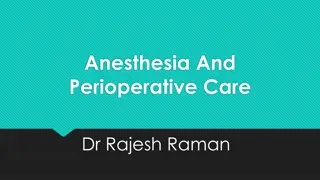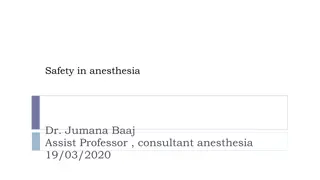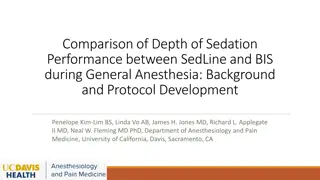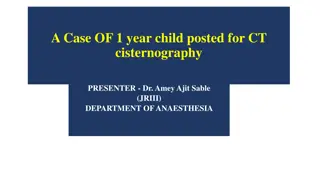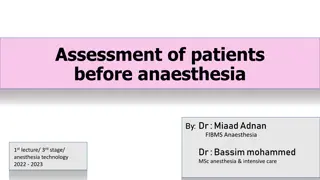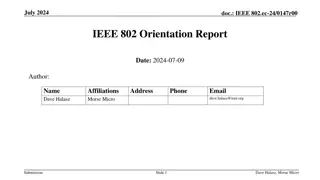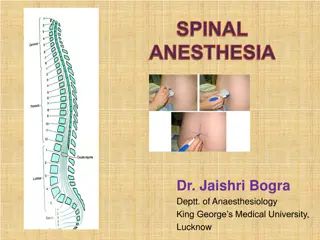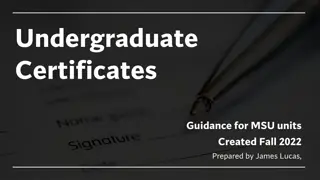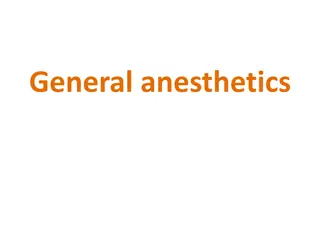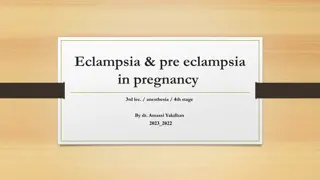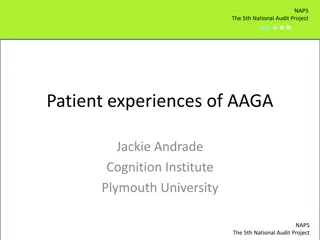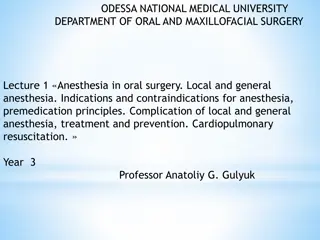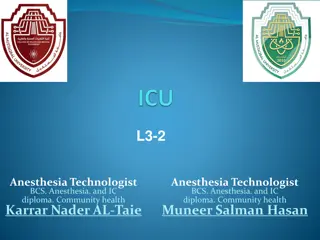Undergraduate Anesthesia Course Orientation
Guide for 4th-year medical students in Anesthesia Electives course, offering structured approach for learning anesthesia basics. Course provides consistent learning experience covering various aspects of anesthesia practice.
Download Presentation

Please find below an Image/Link to download the presentation.
The content on the website is provided AS IS for your information and personal use only. It may not be sold, licensed, or shared on other websites without obtaining consent from the author.If you encounter any issues during the download, it is possible that the publisher has removed the file from their server.
You are allowed to download the files provided on this website for personal or commercial use, subject to the condition that they are used lawfully. All files are the property of their respective owners.
The content on the website is provided AS IS for your information and personal use only. It may not be sold, licensed, or shared on other websites without obtaining consent from the author.
E N D
Presentation Transcript
UNDER GRADUATE ANESTHESIA COURSE (ORIENTATION AND OUTLINE) DR. JUMANA BAAJ ASSISSTANT PROFFESOR , ANESTHESIA CONSULTANT 45 COURSE ORGANIZER KKUH-KSU
TABLE OF CONTENTS: Introduction Welcome The roles of the Anesthesiologist Orientation Hours of attendance Code of conduct Learning Resources Objectives
Introduction This is a guide for the Undergraduate Electives Course in Anesthesia. Its purpose is to provide a course outline for 4thyear medical students. By creating a structured approach we hope to provide a consistent experience for students learning the basics of anesthesia.
Welcome Welcome to this two week introduction to Clinical Anesthesiology. During your short exposure to this specialty we hope to give you some idea of the true scope of anesthesia; it encompasses many areas of medicine as well as clinical physiology and pharmacology. Anesthesiologists learn to use technical and analytical skills to look after patients in many situations some are routine and others very challenging. The course will be relevant to many medical specialties and is not solely aimed at students considering anesthesia residency.
Clinical Objectives for Medical Students in (045) Anesthesia and CPR Course At the end of the course the student will be able to understand and practice: Pre-anesthesia assessment and evaluation 1. Able to take history from patient 2. Able to open PAC System to get information and investigation. 3. Interpretation of preoperative data relevant to anaethetic plan. 4. Consultations
Clinical Objectives for Medical Students in (045) Anesthesia At the end of the course the student will be able to understand and practice: Pre-anesthesia assessment and evaluation Able to take history from patient 1. Able to open PAC System to get information and investigation. 2. Interpretation of preoperative data relevant to anaethetic plan. 3. Consultations Orientation with anesthesia equipment in O.R 4. Anesthesia machine 1. Anesthesia circuits 2. Laryngoscopes tubes LMA Airways 3. Epidural set &Spinal set 4. Monitors- Anesthesia Record 5. Anesthetics Drugs- I.V. Inhalational & Muscle Relaxants 6. Resuscitation Drugs During Anesthesia 7. fluids (Crystalloids & Colloids Fluids) 8.
Clinical Objectives for Medical Students in (045) Anesthesia and CPR Course Peri arrest arrhythmias session Detection of common arrhythmias associated or preceeded cardiac arrest Orientation with defibrillator and indication for use Drugs used during resuscitation session interactive discussion about drugs indicators and pharmacology. Advanced Life Support Algorism Color code Student running scenario as a team leader and rotation between them
Code of conduct Professionalism and Respectful Workplace All students are expected to demonstrate respect for the patients and staff encountered during the rotation. We also expect all students to be treated with respect during their rotation. Health has clear policies regarding: Maintenance of patient confidentiality. Mutual respect in the workplace. If you have concerns regarding lapses in these areas, please address them with your site coordinator.
Code of conduct Professionalism cont d Attendance and punctuality are mandatory. Students are expected to be aware of the limitations of their role in the operating room and to be diligent in the OR environment.
Code of conduct Dress code When in the OR, students must respect the rules of the sterile environment and wear greens, mask, gloves and bootes. If you have not previously been in the OR, please notify us so we can make you aware of appropriate protocol. You are expected to bring your stethoscope to the OR. Other medical instruments are not mandatory.
LEARNING RESOURCES FOR undergrad Anesthesia course Exposure to anesthesia learning in the following areas: Adult OR Pediatric OR Teaching at the bedside in the OR: Clinical teaching modules to cover basic anesthesia knowledge. Enabling objectives for technical skills. Case based clinical teaching Independent learning: Reference material- texts and web-based Simulator based learning: Low and high fidelity simulation to facilitate technical skills, crisis resource management, and critical anesthesia events.
Goals and objectives Academic and Clinical skills: Preoperative evaluation and clinical skills Airway and ventilation Fluid and volume resuscitation, electrolyte balance and acid-base Pharmacology of anesthetic drugs Principles of general anesthesia Principles of regional anesthesia Pain management Monitoring in anesthesia Post operative management
Preoperative evaluation and Clinical skills Students should be able to: Obtain a relevant medical, surgical and anesthetic history and perform a focused pre- operative examination on the patient. ( Airway assessment, and awareness of factors predisposing to difficult intubation are of particular importance.) Provide a summary of pre-operative assessment and formulate a relevant problem list. Have some understanding of the indications for both routine and special pre- operative investigations. Understand the basis of an anesthetic plan and how it relates to the clinical work-up of the patient, and the ASA classification of pre-operative physical status.
Airway and ventilation Know the anatomy of the airway and basic airway assessment. Be familiar with the various techniques of airway management and equipment involved in routine and difficult intubation. Review basic respiratory physiology in the context of anesthesia. Be familiar with the principles of manual and mechanical ventilation.
fluid and electrolyte balance Know the main principles of: Fluid replacement and volume resuscitation (crystalloid, colloid, blood transfusion) Electrolyte and acid-base balance
Pharmacology of anesthetic drugs Have a basic knowledge of the pharmacokinetic and pharmacodynamic principles of drugs commonly involved in anesthesia including: Intravenous agents (sedative/ hypnotics, narcotics, muscle relaxants) Volatile agents. Local anesthetics
Principles of general Anesthesia Understand the principles of general anesthesia and the delivery of volatile anesthetics. Have a basic understanding of the structure, function and safety features of the anesthesia machine.
Regional anesthesia and Pain management Be familiar with the concept of local and regional anesthesia and commonly used local anesthetic agents. Be familiar with perioperative pain management techniques and drugs. Local anesthesia toxicity
Monitoring In anesthesia Be familiar with the major international monitoring standards and be able to interpret basic information gained from the monitoring of: Blood pressure Pulse oximetry ECG Capnography Ventilation (parameters, spirometry) Temperature Invasive pressure monitoring ( CVP, arterial line) Bispectral index
Intra and post operative management Gain an appreciation for the basic management of common intra-operative problems such as: Hypoxia, hypercarbia, Hyper/hypotension, cardiac arrhythmias, High and low airway pressure alarm. Have an understanding of the requirements for safe emergence from general anesthesia and common problems and complications in the PORR. Post op nausea and vomiting, pain etc
The anesthetic plan Type of anesthesia General Airway management Induction Maintenance Muscle relaxation Sedation Supplemental oxygen Agents Local or regional anesthesia Technique Agents
The anesthetic plan Intraoperative management Monitoring Positioning Fluid management Special techniques Postoperative Pain control Complication management Intensive care Postoperative ventilation Hemodynamic monitoring
Stages of the Peri-Operative Period Pre-Operative From time of decision to have surgery until admitted into the OR theatre.
Stages of the Peri-Operative Period Intra-Operative Time from entering the OR theatre to entering the Recovering Room or Post Anesthetic Care Unit (PACU)
Stages of the Peri-Operative Period Post-Operative Time from leaving the RR or PACU until time of follow-up evaluation (often as out- patient)
Key Success Factors Attendance Realistic Expectations Maintains communication with the faculty member Good organizational skills Expect to work beyond the classroom Stay on track/understand commitment required Ask questions
Books recommended. Morgan and Mekhails clinical anesthesiology fifth edition .5th Edition . John Butterworth, G. Morgan, John Wasnick, Mikhail Maged, David C. Mackey, Hans-Joachim Priebe Anesthesia for medical students Literature & manual provided by DEPT. of ANESTHESIA
CONTACT INFORMATION DEPARTMENT 92019 Dr jumana Dr Waleed SIS NINA 4692359 tel. 4692184 BLEEP 0320 4692356 BLEEP 1258
At the end of the course EXAMINATION PRACTICAL EXAMINATION OSCE EXAMINATION WRITTEN


